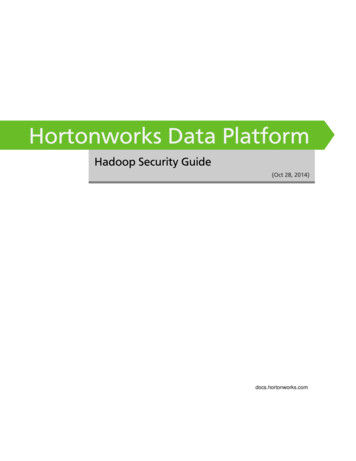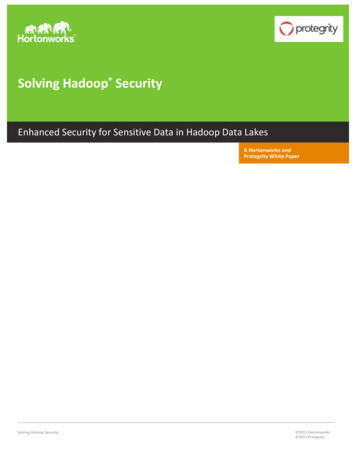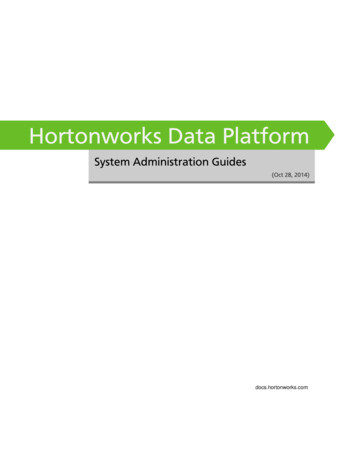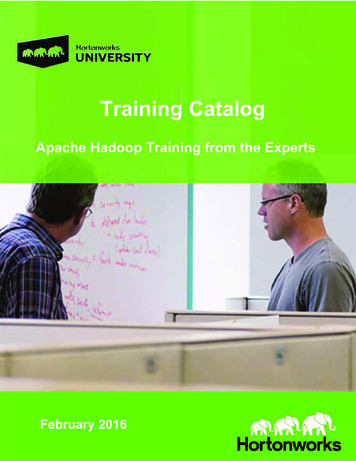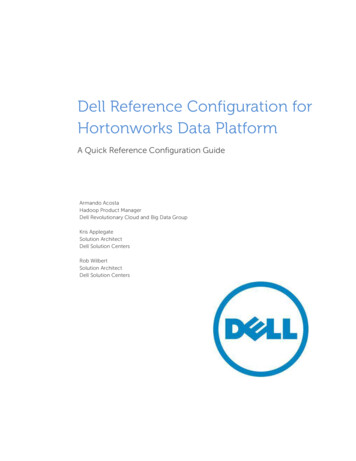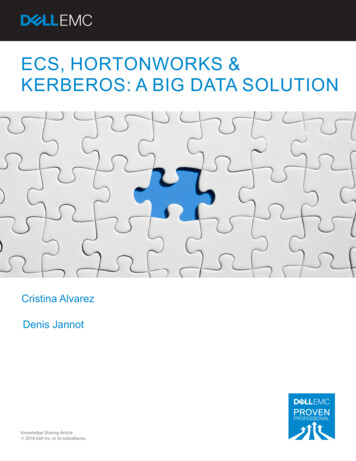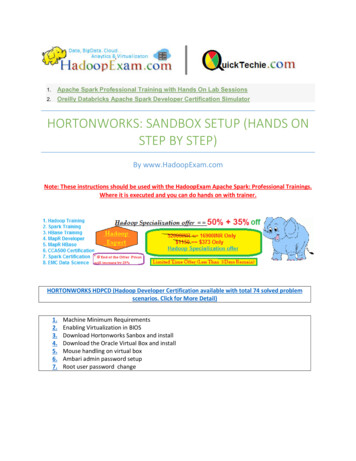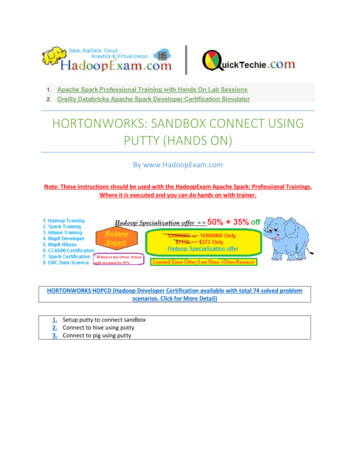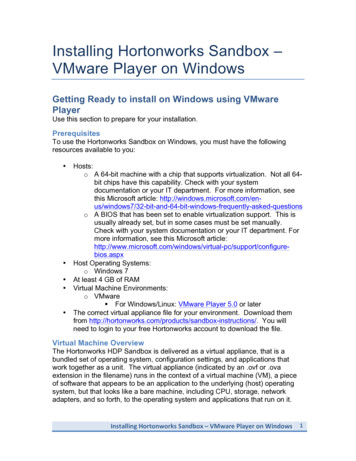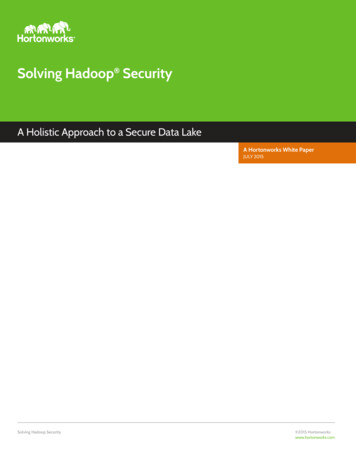
Transcription
Solving Hadoop SecurityA Holistic Approach to a Secure Data LakeA Hortonworks White PaperJULY 2015Solving Hadoop Security 2015 Hortonworkswww.hortonworks.com
2ContentsOverview3Understanding the security implications of the Data Lake3Only as secure as the weakest link4Commitment to enterprise-readiness6Administration6Authentication and perimeter security7Authorization9Audit11Data protection12Enabling extensibility through a pluggable framework13Comparison across security pillars13Summary14About Hortonworks14Solving Hadoop Security 2015 Hortonworkswww.hortonworks.com
3OverviewAs companies rush to put Big Data to work for their business, new ways of operating can sometimesget ahead of IT’s ability to digest their full implications. There’s no question that the creation of aHadoop-powered Data Lake can provide a robust foundation for a new generation of analytics andinsight, but it’s important to consider security before launching or expanding a Hadoop initiative. Bymaking sure that data protection and governance are built into your Big Data environment, you canleverage the full value of advanced analytics without exposing your business to new risks.Hortonworks understands the importance of security and governance for every business. To ensure effective protection forour customers, we use a holistic approach based on five pillars: Administration Authentication and perimeter security Authorization Audit Data protectionIn each of these areas, Hortonworks provides differentiated capabilities beyond those of other vendors to help customersachieve the highest possible level of protection. As a result, Big Data doesn’t have to incur big risks—and companies can put itto work without sacrificing peace of mind.Understanding the security implications of the Data LakeThe consensus is strong among leading companies in every industry: data is an essential new driver of competitive advantage.Hadoop plays a critical role in the modern data architecture by providing low-cost, scale-out data storage and value-addprocessing. The successful Hadoop journey typically starts with Data Architecture Optimization or new Advanced AnalyticApplications, which leads to the formation of a Data Lake. As existing and new types of data from sensors and machines,server logs, clickstreams, and other sources flow into the Data Lake, it serves as a central repository based on shared Hadoopservices that power deep organizational insights across a large, broad and diverse set of data.The need to protect the Data Lake with comprehensive security is clear. As large and growing volumes of diverse data arestored in the Data Lake, it comes to hold the crown jewels of your company—the vital and often highly sensitive data that hasshaped and driven your business over a long history. However, the external ecosystem of data and operational systemsfeeding the Data Lake is highly dynamic and can introduce new security threats on a regular basis. Users across multiplebusiness units can access the Data Lake freely and refine, explore and enrich its data at will, using methods of their ownchoosing, thereby increasing risks of exposure to unauthorized users. Any internal or external breach of this enterprise-widedata can be catastrophic, from privacy violations, to regulatory infractions, to damage to corporate image and long-termshareholder value. To prevent damage to the company’s business, customers, finances and reputation, IT leaders must ensurethat their Data Lake meets the same high standards of security as any legacy data environment.Solving Hadoop Security 2015 Hortonworkswww.hortonworks.com
4Only as secure as the weakest linkPiecemeal protections are no more effective for a Data Lake than they would be in a traditional repository. There’s no point insecuring the primary access path to the data lake when a user can simply access the same data through a different path.Hortonworks firmly believes that effective Hadoop security depends on a holistic approach. Our framework forcomprehensive security revolves around five pillars: administration, authentication/ perimeter security, authorization, auditand data protection.Five pillars of enterprise securityFigure 1: Requirements for enterprise-grade securitySecurity administrators must address questions and provide enterprise-grade coverage across each of these pillars as theydesign the infrastructure to secure data in Hadoop. If any of these pillars remains weak, it introduces threat vectors to theentire data lake. In this light, your Hadoop security strategy must address all five pillars, with a consistent implementationapproach to ensure their effectiveness.Solving Hadoop Security 2015 Hortonworkswww.hortonworks.com
5Needless to say, you can’t achieve comprehensive protection across the Hadoop stack through an ad-hoc approach. Securitymust be an integral part of the platform on which your Data Lake is built with a combination of bottom-up and top downapproach. This makes it possible to enforce and manage security across the stack through a central point of administration andprevent gaps and inconsistencies. This approach is especially important for Hadoop implementations where new applicationsor data engines are always on the horizon in the form of new Open Source projects, a dynamic scenario that can quicklyexacerbate any vulnerabilities.Hortonworks helps customers maintain the high levels of protection their enterprise data demands by building centralizedsecurity administration and management into the DNA of the Hortonworks Data Platform (HDP). HDP provides anenterprise-ready data platform with rich capabilities spanning security, governance and operations. By implementing securityat the platform level, Hortonworks ensures that security is consistently administered to any application built on top of thedata platform, and makes it easier to build or retire data application without impacting security.Figure 2: Hortonworks Data Platform 2.3Solving Hadoop Security 2015 Hortonworkswww.hortonworks.com
6Commitment to enterprise-readinessHortonworks was founded with the objective to make Hadoop ready for the enterprise and has a strong legacy of significantcontributions in this area. This goal of enterprise-readiness led the original Hadoop team at Yahoo! to develop Kerberos as thebasis for strong authentication in Hadoop. Since that time, Hortonworks has continued to make significant investments insecurity. In May 2014, Hortonworks acquired XA Secure, a leading data security company, to accelerate the delivery of acomprehensive approach to Hadoop security. To be consistent with its mission to develop, distribute and support 100% opensource Apache Hadoop data platform, Hortonworks immediately incorporated the XA Secure technology into theHortonworks Data Platform (HDP), while also converting the commercial solution into an open Apache community projectcalled Apache Ranger.As part of HDP, Hortonworks features comprehensive security that spans across the five security pillars. With this platformapproach, HDP enables IT to meet the requirements of Hadoop security better than any other vendor.Figure 3: Comprehensive security in HDPAdministrationIn order to deliver consistent security administration and management, Hadoop administrators require a centralized userinterface—a single pane of glass that can be used to define, administer and manage security policies consistently across all thecomponents of the Hadoop stack. Hortonworks addressed this requirement through Apache Ranger, an integral part of HDP,which provides a central point of administration for the other four functional pillars of Hadoop security.Solving Hadoop Security 2015 Hortonworkswww.hortonworks.com
7Ranger enhances the productivity of security administrators and reduces potential errors by empowering them to definesecurity policy once and apply it to all the applicable components across the Hadoop stack from a central location.Figure4: Apache Ranger provides a "single pane of glass" for the security administratorOther solutions for Hadoop enterprise security only offer partial administration across authentication, authorization, auditingand data protection/encryption—and lack the centralized administration and management needed for efficient andcomprehensive security.APACHE RANGERCentralized security administrationApache Ranger provides a centralized platform for security policyadministrationAuthentication and perimeter securityEstablishing user identity with strong authentication is the basis for secure access in Hadoop. Users need to reliably identifythemselves and then have that identity propagated throughout the Hadoop cluster to access resources such as files anddirectories, and to perform tasks such as running MapReduce jobs. Hortonworks uses Kerberos, an industry standard, toauthenticate users and resources within Hadoop cluster. Hortonworks has also simplified Kerberos setup, configuration andmaintenance through Ambari 2.0.Solving Hadoop Security 2015 Hortonworkswww.hortonworks.com
8Apache Knox Gateway ensures perimeter security for Hortonworks customers. With Knox, enterprises can confidently extendthe Hadoop REST API to new users without Kerberos complexities, while also maintaining compliance with enterprise securitypolicies. Knox provides a central gateway for Hadoop REST APIs that have varying degrees of authorization, authentication,SSL and SSO capabilities to enable a single access point for Hadoop.Figure 5: Perimeter security with Apache KnoxOther vendors fail to provide a comprehensive solution in this area, instead positioning Kerberos for perimeter security.Kerberos is an essential step for user authentication, but it is not sufficient in itself as it lacks the ability to hide cluster entrypoints and block access at the perimeter. By comparison, Apache Knox was built as a secure API gateway for Hadoop, with theability to block services at the perimeter of the cluster. When using Apache Knox for REST APIs, cluster’s multiple accesspoints are hidden from end users, adding another layer of protection for perimeter security.Apache Knox is a pluggable framework, and a new REST API service can be added easily using a configurable servicesdefinition (Knox Stacks).KERBEROSKerberos-based authenticationAmbari simplifies the setup, configuration and maintenance of KerberosAmbari includes support for Apache Ranger installation and configurationAPACHE KNOXPerimeter securitySolving Hadoop SecurityProvide security to all of Hadoop’s REST and HTTP services 2015 Hortonworkswww.hortonworks.com
9AuthorizationRanger manages fine-grained access control through a rich user interface that ensures consistent policy administration acrossHadoop data access components. Security administrators have the flexibility to define security policies for a database, tableand column or a file, and administer permissions for specific LDAP based groups or individual users. Rules based on dynamicconditions such as time or geography can also be added to an existing policy rule. The Ranger authorization model is highlypluggable and can be easily extended to any data source using a service-based definition.Administrators can use Ranger to define centralized security policy for the following components: Apache Hadoop HDFS Apache Hadoop YARN Apache Hive Apache HBase Apache Storm Apache Knox Apache Solr Apache KafkaRanger works with standard authorization APIs in each Hadoop component and is able to enforce centrally administeredpolicies for any method of accessing the data lake.Figure 6: Fine-grained security policy definition with Apache RangerSolving Hadoop Security 2015 Hortonworkswww.hortonworks.com
10Solutions from other vendors lack the flexibility and rich user interface to enable administrators configure security policy forspecific groups and individual users.In contrast, Ranger provides administrators with deep visibility into the security administration process that is required forauditing purposes. The combination of Ranger’s rich user interface with deep audit visibility makes it highly intuitive to use,enhancing productivity for security administrators.Figure 7: With Apache Ranger, administrators have complete visibility into the security administration processAPACHE RANGERPlatform-wide coverage across Hadoop stackCoverage across HDFS, YARN, Hive, HBase, Storm, Knox, Solr and KafkaFine grain authorizationAuthorize security policies for a database, table and column or a file as well asLDAP based groups or individual userProvide hooks for dynamic policy-basedauthorizationSpecify dynamic conditions in service definitionsFlexibility to define unique conditions by service (HDFS, Hive etc.)Built on pluggable service-based modelSolving Hadoop SecurityCustom plugins can be created for any data store 2015 Hortonworkswww.hortonworks.com
11AuditAs customers deploy Hadoop into corporate data and processing environments, metadata and data governance must be vitalparts of any enterprise-ready data lake. For these reasons, Hortonworks established the Data Governance Initiative (DGI) withAetna, Merck, Target and SAS to introduce a common approach to Hadoop data governance into the open source community.This initiative has since evolved into a new open source project called Apache Atlas. Apache Atlas is a set of core foundationalgovernance services that enables enterprises to effectively and efficiently meet their compliance requirements within Hadoopand allows integration with the complete enterprise data ecosystem. These services include: Search and lineage for datasets Metadata-driven data access control Indexed and searchable centralized auditing operational events Data lifecycle management from ingestion to disposition Metadata interchange with other toolsRanger also provides a centralized framework for collecting access audit history and easily reporting on this data, including theability to filter data based on various parameters.
Solving Hadoop Security Authorization Ranger manages fine-grained access control through a rich user interface that ensures consistent policy administration across Hadoop data access components. Security administrators have the flexibility to define security policies for a database, tableFile Size: 717KBPage Count: 14
